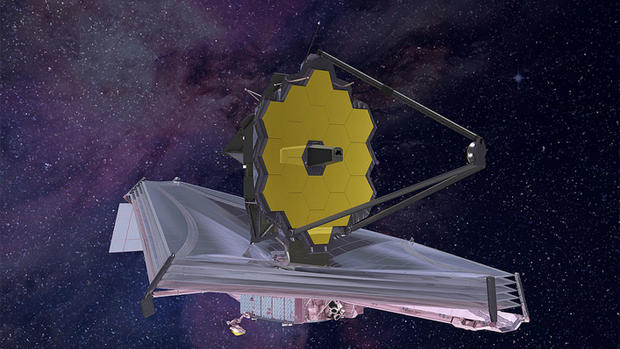After 25 years of Hubble, NASA plans ambitious follow-up
NASA plans to follow up the enormous success of the Hubble Space Telescope with two major space-based observatories, the James Webb Space Telescope, scheduled for launch in late 2018, and the Wide Field Infrared Survey Telescope, or WFIRST, in the mid 2020s.
The James Webb is a $6.5 billion flagship mission featuring a huge, 21-foot-wide segmented mirror three times larger than Hubble's and a suite of instruments optimized for infrared observations. If all goes well, the James Webb will detect light from the first generations of stars and galaxies to form after the big bang birth of the universe.
WFIRST features a mirror donated to NASA by the National Reconnaissance Office, the super-secret agency that operates the nation's spy satellites. The donated mirror, one of two given to NASA, is the same size as Hubble's, but features a much wider field of view.
The James Webb Space Telescope will be roughly 100 times more powerful than Hubble. Among its key science goals are studies of star formation and the evolution of galaxies, studying the atmospheres of planets orbiting other stars and looking for clues about habitability to get a better sense of how common life might, or might not be, across the cosmos.
Like the James Webb, WFIRST will be optimized for infrared observations and will focus on the nature of dark energy and pioneering studies of planets orbiting other stars. The WFIRST observatory will have roughly the same optical power and resolution as Hubble, but it's field of view will be twice as large.
In now-famous "deep field images" taken by Hubble, astronomers focused the telescope on patches of sky that were 50 times smaller than the full moon. In those images, astronomers can make out some 10,000 galaxies.
"In a typical WFIRST deep field, we'll have a million galaxies," said Jason Kalirai, an astronomer at the Space Telescope Science Institute. "Our statistical sense of what's happening in the universe and our interpretation of what those sources mean, will expand exponentially with these tools."
Hubble is still going strong after a quarter century in orbit because spacewalking shuttle astronauts were able to fix its initially blurry vision, replace older instruments with newer, more powerful versions and repair or replace aging components when they broke down.
None of that will be possible for Hubble's successors.
Unlike Hubble, which was placed in a low-Earth orbit reachable by astronaut repair crews, the James Webb Space Telescope will be boosted to Lagrange Point 2, about one million miles from Earth, where the gravity of the sun, Earth and moon roughly balance to allow the observatory to maintain its position with minimal use of rocket fuel.
Equally important, Lagrange Point 2 will allow JWST's sun shade, a complex five-layer parasol the size of a tennis court, to block out the light of the sun, Earth and moon to keep the telescope at the ultra-low temperatures needed for its instruments to capture the faint infrared light of the very first stars and galaxies.
After release from a European Ariane 5 rocket, the JWST will unfold like a robotic origami. First, telescoping rods will extend, pulling the sunshade open and separating its layers. Then the segments making up Webb's primary mirror will unfold, along with the support beams for the telescope's secondary mirror.
Unlike Hubble, the Webb was not designed to be serviced by astronauts. NASA's Orion spacecraft, the only piloted vehicle under development that could even reach JWST, is not equipped with any sort of robot arm or any analogue of the shuttle's payload bay where servicing could be attempted. JWST has to work right out of the box.
And also unlike Hubble, NASA does not expect to still be receiving images from Webb when its 25th anniversary rolls around. Or even its 20th. While only a small amount of fuel is needed to maintain the observatory's place at Lagrange Point 2, what propellant there is will run out after about 10 years.
Hubble is "an experiment in extreme serviceability," said John Grunsfeld, veteran of three shuttle servicing missions and NASA's current director of space science. "On the other extreme is James Webb, with no serviceability whatsoever. And so, as a society, we do these experiments. I'm hoping the James Webb experiment works out well."
When he came on board as NASA's associate administrator for space science, Grunsfeld argued, unsuccessfully, to add a small grapple fixture to the James Webb so "if something goes wrong, we could send a little, teeny spacecraft out and just shake it gently, to unfurl something," he said.
"But it was too late in the design cycle to do anything like that," he said. "So it is a grand experiment."



